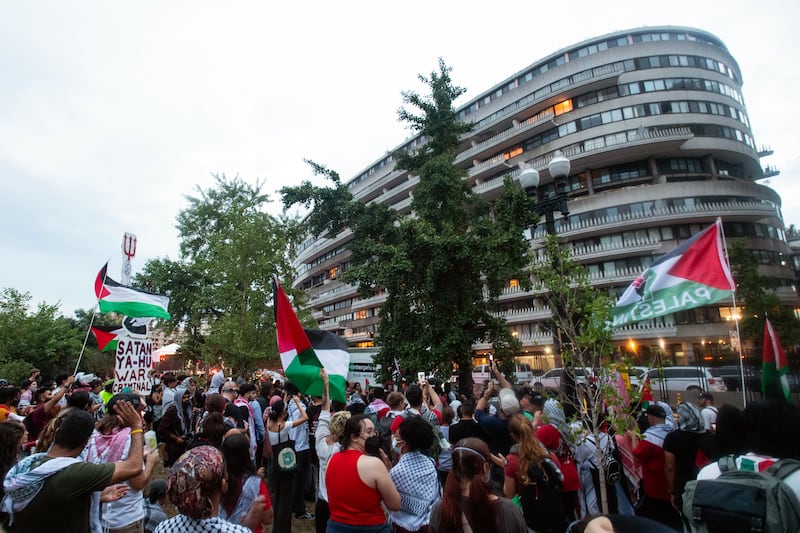Israeli prime minister Binyamin Netanyahu, in a defiant address to members of Congress on Wednesday, defended his country’s war with Hamas in the Gaza Strip and criticised US protesters and international human rights groups.
Some of his remarks have been disputed by human rights groups, and others are unverifiable or lacked context. Here’s a closer look.
What Was Said: International Criminal Court
“The prosecutor of the International Criminal Court has shamefully accused Israel of deliberately starving the people of Gaza. This is utter, complete nonsense. It’s a complete fabrication. Israel has enabled more than 40,000 aid trucks to enter Gaza. That’s half a million tons of food, and that’s more than 3,000 calories for every man, woman and child in Gaza.”
Aid groups and the United Nations have warned that hundreds of thousands of people in Gaza face starvation and that the strip is on the brink of famine.
READ MORE
Netanyahu contended that none of that was Israel’s fault, and referred to one analysis of aid that has entered Gaza. In a working paper using data from Cogat, the Israeli military agency co-ordinating aid delivery, academics in Israel calculated that more than 14,000 aid trucks had entered Gaza from January to April and provided food equivalent to more than 3,300 calories per day.
But the number of trucks allowed into the strip and the amount of aid they carry have been in dispute. Israel and the United Nations used different methodologies to track the deliveries. Moreover, once aid enters Gaza, it is not clear how much reaches those in need. NPR recently reported on sacks of flour and boxes of fruit and vegetables piling up on the Gaza side of a crossing. Humanitarian groups told National Public Radio in the US that difficulties in co-ordinating movement with the Israeli military, the continuing fighting, fuel shortages and looting were all obstacles to delivering that aid.
Scott Paul, the associate director for peace and security at Oxfam America, said Netanyahu’s estimate “does not line up with what the humanitarian community is seeing in real time”.
Paul also noted that Israel’s bombardment has destroyed Gaza residents’ ability to produce food, prices have skyrocketed in the strip and aid workers face a number of bureaucratic hurdles and delays.
[ Mark Weiss: Netanyahu hopes speech will improve his image in IsraelOpens in new window ]
“The amount of trucks or calories is also somewhat beside the point while the fact remains that all of Gaza is at risk of famine,” Paul added.
An April analysis from Oxfam, using data from the United Nations, found that people in northern Gaza, one of the hardest-hit areas, were surviving on just 245 calories a day – far less than the 3,000 calories Netanyahu cited and far less than the average recommended daily caloric intake.

What Was Said: Iran links to US demonstrations
“We recently learned from the national security director – the US director of national intelligence, that Iran is funding and promoting anti-Israel protests in America. They want to disrupt America.”
Avril D Haines, the director of national intelligence, said in a statement in July that intelligence agencies had observed people with ties to Iran posing as protesters, encouraging demonstrations online and providing financial support. She did not offer specifics on the size of the influence operation or just how much funding they had provided. Moreover, Haines also emphasised that the existence of such actors did not mean that all protesters were disingenuous.
“I want to be clear that I know Americans who participate in protests are, in good faith, expressing their views on the conflict in Gaza – this intelligence does not indicate otherwise,” she said, adding that Americans targeted by Iranian-linked accounts may not be aware and should remain vigilant when interacting with accounts online that they do not personally know.
In May, Haines testified before Congress that Iran had been “increasingly aggressive in their efforts seeking to stoke discord and undermine confidence in our democratic institutions.” But she said that Russia remained the most active threat to US elections as it operates a “vast multimedia influence apparatus.”
What Was Said: Casualties in Gaza
“That’s why despite all the lies you’ve heard, the war in Gaza has one of the lowest ratios of combatants to non-combatants casualties in the history of urban warfare.”
It is difficult to compare casualty counts across conflicts given the challenges of corroborating such information in war zones and the unique circumstances of each battle.
As a result of the conflict between Israel and Hamas, more than 39,000 people have been killed in the nine months of the war, according to health officials in Gaza. But just how many are combatants and how many are civilians is difficult to independently verify and often disputed.
In May, Israel estimated that about 14,000 combatants and 16,000 civilians had been killed. That would be a ratio of roughly 0.8 combatant deaths for every one civilian death.
That month, the United Nations reported that nearly 13,000 of the dead were women and children, while 10,000 were men. More than 10,000 other people had been killed at that point, but authorities in Gaza were waiting on more identifying information before including them in a demographic breakdown. It is unclear how many were civilians versus combatants.
No two wars are the same, making any comparison overly simplistic.
Russia’s invasion of Ukraine, for example, has been fought in cities and rural areas alike and is between two nation-states, but it has also lasted more than twice as long as the Israel-Hamas war. That conflict has led to more than 11,000 civilian deaths. Ukrainian president Volodymyr Zelenskiy estimated in February that about 31,000 Ukrainian soldiers had been killed, while US officials estimated 70,000 last summer. That would be a ratio of 2.8 to 6.4 combatant deaths to every one civilian death.
– This article originally appeared in The New York Times.













